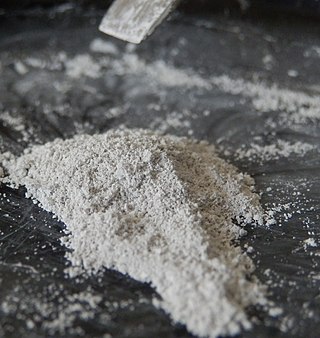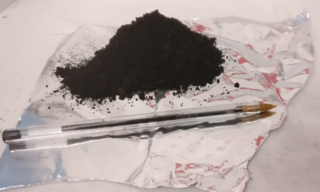Related Research Articles
Carbon compounds are defined as chemical substances containing carbon. More compounds of carbon exist than any other chemical element except for hydrogen. Organic carbon compounds are far more numerous than inorganic carbon compounds. In general bonds of carbon with other elements are covalent bonds. Carbon is tetravalent but carbon free radicals and carbenes occur as short-lived intermediates. Ions of carbon are carbocations and carbanions are also short-lived. An important carbon property is catenation as the ability to form long carbon chains and rings.
An inorganic compound is typically a chemical compound that lacks carbon–hydrogen bonds—that is, a compound that is not an organic compound. The study of inorganic compounds is a subfield of chemistry known as inorganic chemistry.

Thiocyanates are salts containing the thiocyanate anion [SCN]−. [SCN]− is the conjugate base of thiocyanic acid. Common salts include the colourless salts potassium thiocyanate and sodium thiocyanate. Mercury(II) thiocyanate was formerly used in pyrotechnics.

Thiocyanic acid is a chemical compound with the formula HSCN and structure H−S−C≡N, which exists as a tautomer with isothiocyanic acid. The isothiocyanic acid tautomer tends to dominate with the compound being about 95% isothiocyanic acid in the vapor phase.
In chemical nomenclature, the IUPAC nomenclature of inorganic chemistry is a systematic method of naming inorganic chemical compounds, as recommended by the International Union of Pure and Applied Chemistry (IUPAC). It is published in Nomenclature of Inorganic Chemistry. Ideally, every inorganic compound should have a name from which an unambiguous formula can be determined. There is also an IUPAC nomenclature of organic chemistry.
A solubility chart is a chart describing whether the ionic compounds formed from different combinations of cations and anions dissolve in or precipitate from solution.

Mercury(II) thiocyanate is an inorganic chemical compound, the coordination complex of Hg2+ and the thiocyanate anion. It is a white powder. It will produce a large, winding "snake" when ignited, an effect known as the Pharaoh's serpent.

Potassium thiocyanate is the chemical compound with the molecular formula KSCN. It is an important salt of the thiocyanate anion, one of the pseudohalides. The compound has a low melting point relative to most other inorganic salts.
The tables below provides information on the variation of solubility of different substances in water with temperature, at one atmosphere pressure. Units of solubility are given in grams of substance per 100 millilitres of water, unless shown otherwise. The substances are listed in alphabetical order.

Hypoiodous acid is an inorganic compound with the chemical formula HIO. It forms when an aqueous solution of iodine is treated with mercuric or silver salts. It rapidly decomposes by disproportionation:

Thiocyanogen, (SCN)2, is a pseudohalogen derived from the pseudohalide thiocyanate, [SCN]−, with behavior intermediate between dibromine and diiodine. This hexatomic compound exhibits C2 point group symmetry and has the connectivity NCS-SCN.

Cobalt(II) thiocyanate is an inorganic compound with the formula Co(SCN)2. The anhydrous compound is a coordination polymer with a layered structure. The trihydrate, Co(SCN)2(H2O)3, is a isothiocyanate complex used in the cobalt thiocyanate test (or Scott test) for detecting cocaine. The test has been responsible for widespread false positives and false convictions.
Lead(II) thiocyanate is a compound, more precisely a salt, with the formula Pb(SCN)2. It is a white crystalline solid, but will turn yellow upon exposure to light. It is slightly soluble in water and can be converted to a basic salt (Pb(CNS)2·Pb(OH)2 when boiled. Salt crystals may form upon cooling. Lead thiocyanate can cause lead poisoning if ingested and can adversely react with many substances. It has use in small explosives, matches, and dyeing.

Ammonium thiocyanate is an inorganic compound with the formula [NH4]+[SCN]−. It is an ammonium salt of thiocyanic acid. It consists of ammonium cations [NH4]+ and thiocyanate anions [SCN]−.

Silver thiocyanate is the silver salt of thiocyanic acid with the formula AgSCN. Silver thiocyanate appears as a white crystalline powder. It is very commonly used in the synthesis of silver nanoparticles. Additionally, studies have found silver nanoparticles to be present in saliva present during the entire digestive process of silver nitrate. Silver thiocyanate is slightly soluble in water, with a solubility of 1.68 x 10−4 g/L. It is insoluble in ethanol, acetone, and acid.

Copper(I) thiocyanate is a coordination polymer with formula CuSCN. It is an air-stable, white solid used as a precursor for the preparation of other thiocyanate salts.
Barium thiocyanate refers to salts of the formula Ba(SCN)2.xH2O. Both an anhydrous salt and a trihydrate are known. The anhydrous salt is hygroscopic. The trihydrate is soluble in most alcohols but insoluble in simple alkanes. Barium thiocyanate is used in dyeing textiles and in some photographic solutions. But because of its toxicity, it has limited uses.

Copper(II) thiocyanate (or cupric thiocyanate) is a coordination polymer with formula Cu(SCN)2. It is a black solid which slowly decomposes in moist air. It was first reported in 1838 by Karl Ernst Claus and its structure was determined first in 2018.
Lithium thiocyanate is a chemical compound with the formula LiSCN. It is an extremely hygroscopic white solid that forms the monohydrate and the dihydrate. It is the least stable of the alkali metal thiocyanates due to the large electrostatic deforming field of the lithium cation.

Strontium thiocyanate refers to the salt Sr(SCN)2. It is a colorless solid. According to X-ray crystallography, it is a coordination polymer. The Sr2+ ions are each coordinated to eight thiocyanate anions in a distorted square antiprismatic molecular geometry where each square face contains two adjacent S atoms and two adjacent N atoms. The motif is reminiscent of the fluorite structure. The same structure is observed for Ca(SCN)2, Ba(SCN)2, and Pb(SCN)2.
References
- ↑ Cliffe, Matthew J. (2024). "Inorganic Metal Thiocyanates". Inorganic Chemistry. 63 (29): 13137–13156. doi:10.1021/acs.inorgchem.4c00920. PMC 11271006 . PMID 38980309.